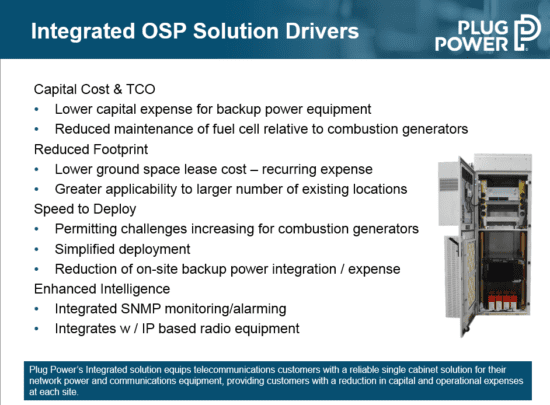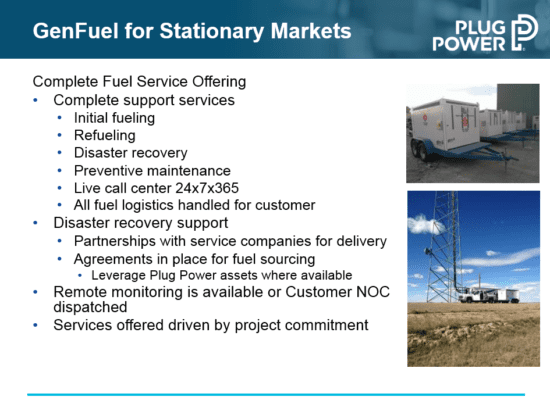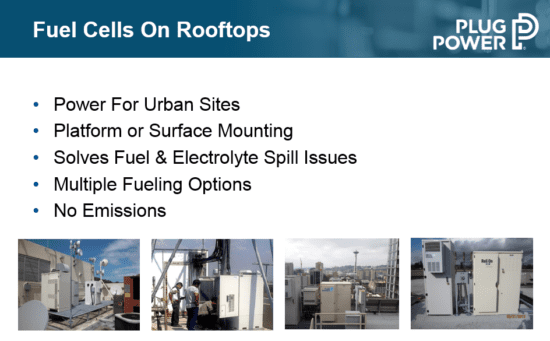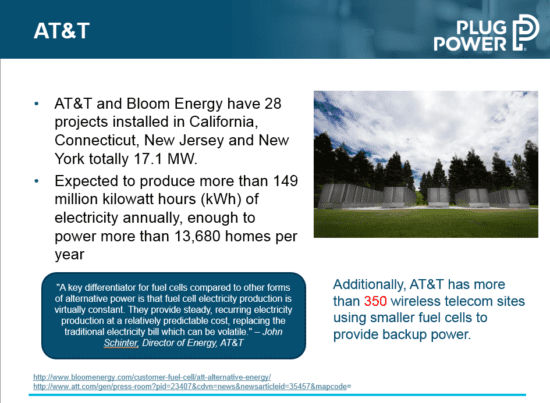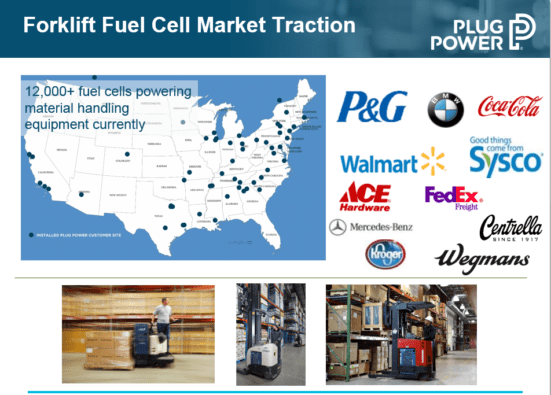5 Evolutions in Fuel Cells for Telecom
National Hydrogen and Fuel Cell Day (10.08) was created  to help raise awareness of a clean energy technology that is here now. We’re celebrating all week. This project highlights real-world applications for these solutions, today.
to help raise awareness of a clean energy technology that is here now. We’re celebrating all week. This project highlights real-world applications for these solutions, today.
5 Evolutions in Fuel Cells for Telecom
By Darin Painter, Executive Director of Sales, Stationary Power
Last month, while at ISE EXPO in San Antonio, TX, I spoke to telecommunications professionals about some important advancements in fuel cells that can help evolve the way they address power within their networks. Here are some highlights from that presentation.
Fuel cell solutions have evolved significantly since they were introduced to telecommunications in 2003. The fuel cell market has grown from a very small number of installations to thousands of sites located in 46 U.S. states. Currently, every major domestic carrier utilizes fuel cells in its network to provide backup power. The manner in which telecom fuel cells are utilized today is similar, yet differs substantially, from the way they were used in 2003. These changes will continue to evolve the way backup power is managed in the outside plant environment. Here are five areas of recent evolution in the fuel cell space you should know about.
Outside Plant Power
Hydrogen fuel cells provide improved reliability over diesel generators. Additionally, fuel cells provide operational savings and reduced reporting & spill mitigation requirements as well as helping operators meet their sustainability goals.
One new development is an integrated fuel cell solution for LTE-only sites, which combines the fuel cell systems, DC power and distribution, battery technology and dedicated space for LTE equipment, in an environmentally-hardened outdoor enclosure. The integrated solution combines the function of a traditional communications equipment shelter with a highly reliable, clean, cost-effective power system for 24×7 operations.
Southern Linc Wireless is deploying this solution utilizing Plug Power’s GenSure fuel cells for up to 500 of their new LTE sites over the next five years[1]. The improved power efficiencies of LTE equipment have been a major driver for the integration of the entire system. The solution reduces both capital cost and total cost of ownership. By integrating all necessary components into one enclosure, the site equipment footprint is optimized, resulting in reduced ground space lease requirements. This saves the operator recurring ground lease expense and allows the enclosure to be utilized at sites where space is limited. Speed of installation is improved by enabling a single crew on one visit to install the whole solution. As permitting has become increasingly cumbersome for combustion generators, site acquisition is also made easier.
Fueling Solutions
Hydrogen fuel availability has improved significantly over the past five years. Bulk hydrogen refueling capability was introduced to the market in 2009 in limited locations. As the number of telecommunications fuel cell installations has increased, bulk refueling availability has expanded to more locations.
Bulk refueling for hydrogen functions on the same model as diesel or propane refueling for combustion generators – a truck arrives at the location and refuels the fuel storage system on-site in a matter of minutes. A new development is the ability to contract with a fuel cell provider to manage ongoing fueling for a network of installations.[2] As the hydrogen bulk refueling model continues to grow, the ability to use fuel cells in a disaster recovery scenario is becoming a reality for more regions of the country.
Rooftop Power
Most operators would agree that rooftops pose a unique set of challenges compared to ground-level network installations and, thus, necessitate special considerations when selecting an appropriate backup power solution. Additionally, achieving site acquisition for rooftop locations can be cumbersome. Recent developments in fuel cells have expanded the options available to operators to address many of these issues and are being utilized for a growing number of rooftop installations.
Hydrogen fuel cells simplify siting requirements by offering a safe fuel that does not have spill containment issues like traditional liquid-fueled generators. They offer a weight ratio of approximately 54% of the pounds per square inch of the mass of a generator and 20% of the pounds per square inch of a battery-only solution delivering the same power level, with the additional benefit that the fuel cell solution offers a much longer runtime. Noise associated with a fuel cell is approximately 20 decibels lower compared to a combustion generator, with no issues related to vibration, making the fuel cell a rooftop winner.
Central Office (CO) Power
Fuel cells are no longer confined to the outside plant environment; they are making their way into the central office/switching environment as well. COs have much larger power requirements than outside plant equipment. Thus, they are addressed with a different type of fuel cell.
In the last three years, both AT&T[3] and Verizon[4] have invested in large fuel cells (think hundreds of kilowatts per location, rather than the 2.5kW to 10kW at an outside plant location) to address their COs. These fuel cells are also being used to power corporate offices, call centers, and data centers using natural gas as the fuel source. Fuel cells in this environment help to harden the network against grid service interruption, providing the operator with improved reliability and reduced greenhouse gas emissions and helping operators to meet corporate sustainability goals.
Warehouses
Part of the business of making communication a reality involves managing large amounts of equipment that must be shipped from vendors to operators, where it is stored and deployed to individual locations for installation or site maintenance. Large telecom operators and their partners necessarily have huge warehouses for this purpose.
Warehouses utilize forklift fleets, many of which operate using large batteries that run down during a shift, get swapped with a fresh battery and then are charged for reuse. These large format warehouses typically employ a battery charging/storage room where this process takes place, taking up valuable space and requiring dedicated employees in order to optimize operations. A battery “swap” takes approximately 15 minutes to complete and, in most cases, is required every four to six hours.
Fuel cells have been improving productivity by replacing batteries in forklifts fleets for a growing number of commercial customers over the past several years, including Coca-Cola[5], Walmart[6] and Sysco[7], but have not yet seen traction in telecommunications. Telecommunications warehousing is an area where fuel cells can offer significant productivity and financial savings to carriers and their partners.
Final Thoughts
Fuel cells have much to offer to the telecommunications business model, as we have seen through the advancements in outside plant power, fueling solutions, rooftop power and central office power. Opportunities to advance reliability and business productivity abound in these and new areas including warehouses.
We will continue to see innovation and growth as operators and fuel cell manufacturers work together to develop solutions that solve the myriad challenges faced by operators. Technology is only helpful when it serves the missions of the people who use it. By helping operators to increase the reliability and lower the costs of their networks, telecom fuel cells used at many different points in the system provide a web of growth and sustainability for the whole industry. The world is moving – join us and move boldly into the future. #InfiniteDrive
[1] https://www.plugpower.com/News/PressReleases/15-01-05/PLUG_POWER_IDENTIFIES_SOUTHERNLINC_WIRELESS_AS_MULTI-YEAR_RELION_FUEL_CELL_CUSTOMER.aspx
[2] https://www.plugpower.com/News/PressReleases/15-01-05/PLUG_POWER_IDENTIFIES_SOUTHERNLINC_WIRELESS_AS_MULTI-YEAR_RELION_FUEL_CELL_CUSTOMER.aspx
[3] http://www.att.com/gen/press-room?pid=23407&cdvn=news&newsarticleid=35457
[4] http://www.reuters.com/article/2013/04/30/us-verizon-energy-idUSBRE93T0J020130430
[5] http://www.fuelcelltoday.com/news-archive/2012/february/coca-cola-officially-unveils-its-fuel-cell-forklift-fleet
[6] http://gas2.org/2014/03/18/wal-mart-buys-50-million-worth-hydrogen-forklifts/
[7] http://www.hydrogencarsnow.com/blog2/index.php/hydrogenforklifts/sysco-warehouse-opens-with-fuel-cell-forklifts-palette-trucks/

